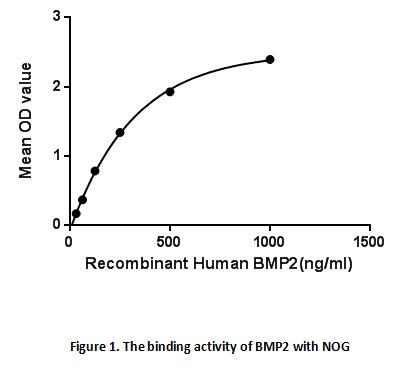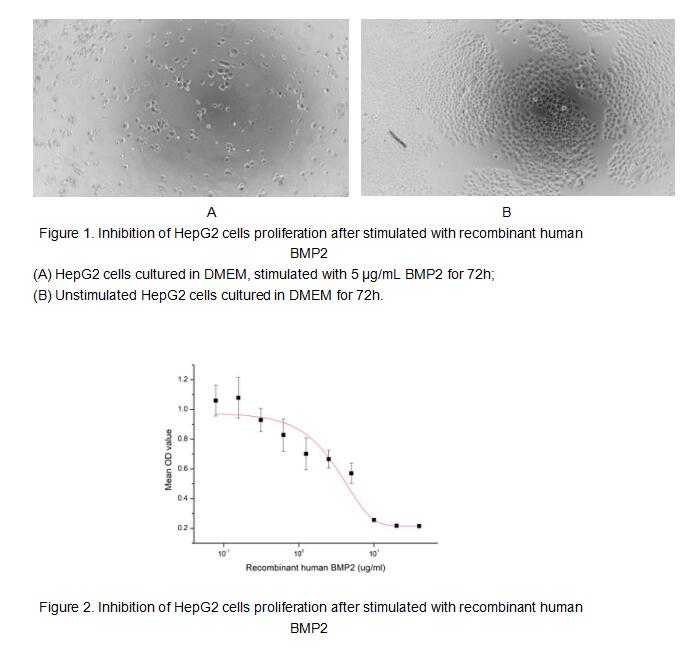Active Bone Morphogenetic Protein 2 (BMP2) 

BMP2A; BMP-2A; Hemochromatosis Modifier
- UOM
- FOB US$ 312.00 US$ 780.00 US$ 1,560.00 US$ 4,680.00 US$ 11,700.00
- Quantity
Overview
Properties
- Product No.APA013Hu01
- Organism SpeciesHomo sapiens (Human) Same name, Different species.
- ApplicationsCell culture; Activity Assays.
Research use only - DownloadInstruction Manual
- CategoryDevelopmental scienceBone metabolism
- Buffer Formulation20mM Tris, 150mM NaCl, pH8.0, containing 1mM EDTA, 1mM DTT, 0.01% SKL, 5% Trehalose and Proclin300.
- Traits Freeze-dried powder, Purity > 97%
- Isoelectric Point7.3
Sign into your account
Share a new citation as an author
Upload your experimental result
Review

Contact us
Please fill in the blank.
Activity test

Bone morphogenetic protein 2(BMP2) belongs to the TGF-β superfamily of proteins. It plays an important role in the development of bone and cartilage. It is involved in the hedgehog pathway, TGF beta signaling pathway, and in cytokine-cytokine receptor interaction. BMP2 is also involved in cardiac cell differentiation and epithelial to mesenchymal transition. Like many other proteins from the BMP family, BMP2 has been demonstrated to potently induce osteoblast differentiation in a variety of cell types. Besides, Noggin (NOG) has been identified as an interactor of BMP2, thus a binding ELISA assay was conducted to detect the interaction of recombinant human BMP2 and recombinant human NOG. Briefly, BMP2 were diluted serially in PBS, with 0.01% BSA (pH 7.4). Duplicate samples of 100ul were then transferred to NOG-coated microtiter wells and incubated for 2h at 37℃. Wells were washed with PBST and incubated for 1h with anti-BMP2 pAb, then aspirated and washed 3 times. After incubation with HRP labelled secondary antibody, wells were aspirated and washed 3 times. With the addition of substrate solution , wells were incubated 15-25 minutes at 37℃. Finally, add 50µL stop solution to the wells and read at 450nm immediately. The binding activity of BMP2 and NOG was shown in Figure 1, and this effect was in a dose dependent manner.

To test the effect of BMP2 on cell apoptosis, HepG2 cells were seeded into triplicate wells of 96-well plates at a density of 4,000 cells/well and allowed to attach overnight, then the medium was replaced with various concentrations of recombinant human BMP2 diluted with 5% serum standard DMEM. After incubated for 72h, cells were observed by inverted microscope and cell proliferation was measured by Cell Counting Kit-8 (CCK-8). Briefly, 10 µl of CCK-8 solution was added to each well of the plate, then the absorbance at 450 nm was measured using a microplate reader after incubating the plate for 1-4 hours at 37 ℃. Apoptosis of HepG2 cells after incubation with BMP2 for 72h observed by inverted microscope was shown in Figure 1. Cell viability was assessed by CCK-8 (Cell Counting Kit-8 ) assay after incubation with recombinant human BMP2 for 72h. The result was shown in Figure 2. It was obvious that BMP2 significantly decreased cell viability of HepG2 cells. The ED50 of recombinant human BMP2 is 3.25 ug/ml.
Usage
Reconstitute in 20mM Tris, 150mM NaCl (PH8.0) to a concentration of 0.1-1.0 mg/mL. Do not vortex.
Storage
Avoid repeated freeze/thaw cycles. Store at 2-8°C for one month. Aliquot and store at -80°C for 12 months.
Stability
The thermal stability is described by the loss rate. The loss rate was determined by accelerated thermal degradation test, that is, incubate the protein at 37°C for 48h, and no obvious degradation and precipitation were observed. The loss rate is less than 5% within the expiration date under appropriate storage condition.
Increment services
-
 BCA Protein Quantification Kit
BCA Protein Quantification Kit
-
 Molecular Mass Marker for Protein
Molecular Mass Marker for Protein
-
 Monoclonal Antibody Customized Service
Monoclonal Antibody Customized Service
-
 Polyclonal Antibody Customized Service
Polyclonal Antibody Customized Service
-
 Protein Activity Test Experiment Service
Protein Activity Test Experiment Service
-
 Electrophoretic Mobility Shift Assay (EMSA) Experiment Service
Electrophoretic Mobility Shift Assay (EMSA) Experiment Service
-
 Buffer
Buffer
-
 Lentivirus Packaging Experiment Service
Lentivirus Packaging Experiment Service
-
 Adenovirus Packaging Experiment Service
Adenovirus Packaging Experiment Service
-
 Real Time PCR Experimental Service
Real Time PCR Experimental Service
-
 Spike RBD Protein (S-RBD)
Spike RBD Protein (S-RBD)
-
 Protein G
Protein G
-
 Protein A
Protein A
Citations
- Chronic exposure to low concentrations of strontium 90 affects bone physiology but not the hematopoietic system in miceWiley: Source
- A Combinatorial Relative Mass Value Evaluation of Endogenous Bioactive Proteins in Three-Dimensional Cultured Nucleus Pulposus Cells of Herniated Intervertebral Discs: Identification of Potential Target Proteins for Gene Therapeutic ApproachesPlosone: Source
- Effect of transplantation of BMP-2-induced bone marrow mesenchymal stem cells on myocardial infarction of rats after reperfusionSource
- PDGF-AA promotes osteogenic differentiation and migration of mesenchymal stem cell by down-regulating PDGFRα and derepressing BMP-Smad1/5/8 signalingPubmed:25470749
- Negative effect of serotonin–norepinephrine reuptake inhibitor therapy on rat bone tissue after orchidectomyPubMed: 25934570
- Effect of Mirtazapine on Rat Bone Tissue after OrchidectomyPubMed: 25871861
- Titanium with Nanotopography Induces Osteoblast Differentiation by Regulating Endogenous Bone Morphogenetic Protein Expression and Signaling PathwayPubMed: 26681207
- Sustained dual release of placental growth factor-2 and bone morphogenic protein-2 from heparin-based nanocomplexes for direct osteogenesisPubmed:27042064
- EFFECTS OF FLUORIDE ON THE EXPRESSION OF BMP-2 AND SMAD1 IN RAT OSTEOBLASTS IN VITROfiles:p013-022
- Unveiling the interactions among BMPR-2, ALK-1 and 5-HTT genes in the pathophysiology of HAPEPubmed:27196063
- Extracellular Matrix Powder from Cultured Cartilage-Like Tissue as Cell Carriers for Cartilage RepairDOI:10.1039/C7TB00640C
- 3D- Printed Poly(ε-caprolactone) Scaffold Integrated with Cell-laden Chitosan Hydrogels for Bone Tissue Engineering.pubmed:29042614
- Demineralized dentin and enamel matrices as suitable substrates for bone regenerationpubmed:28731486
- Peroxisome proliferator‐activated receptor γ plays dual roles on experimental periodontitis in ratsPubmed:29574908
- Effects of Amlodipine on Bone Metabolism in Orchidectomised Spontaneously Hypertensive RatsPubmed:29898457
- BMP-2 and type I collagen preservation in human deciduous teeth after demineralizationPubmed:30045659
- Enhanced osteogenic differentiation of MC3T3-E1 on rhBMP-2 immobilized titanium surface through polymer-mediated electrostatic interaction
- Injectable hydrogels from enzyme-catalyzed crosslinking as BMSCs-laden scaffold for bone repair and regeneration
- Development of CaCO 3 microsphere-based composite hydrogel for dual delivery of growth factor and Ca to enhance bone regeneration
- The dose-time effects of fluoride on the expression and DNA methylation level of the promoter region of BMP-2 and BMP-7 in ratsPubmed: 32004919
- Biofabrication and application of decellularized bone extracellular matrix for effective bone regeneration
- Synergistic Effect of Platelet-rich Fibrin Releasate and Bone Marrow Stem Cells in Preventing Bone Loss in Ovariectomized Mouse
- New design to remove leukocytes from platelet-rich plasma (PRP) based on cell dimension rather than density33842739
- Osteogenic and Angiogenic Potency of VEGF165-Transfected Canine Bone Marrow Mesenchymal Cells Combined with Coral Hydroxyapatite in Vitro34302695
- The WNT/β-catenin signalling pathway induces chondrocyte apoptosis in the cartilage injury caused by T-2 toxin in rats34742779
- Polydopamine-Coated Poly(l-lactide) Nanofibers with Controlled Release of VEGF and BMP-2 as a Regenerative Periosteum34472855
- Efficacy of Total flavonoids of Rhizoma drynariae on the Blood Vessels and the Growth Quality of Bone Graft in the Induced MembranePubmed:35278899








